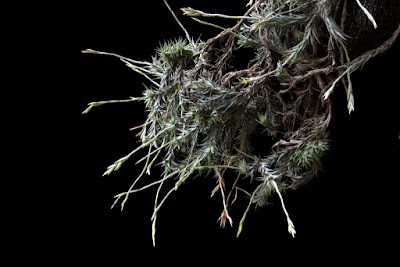Tillandsia tricholepis is native to Bolivia, Paraguay, Argentina, and Brazil. It grows as an epiphyte at the tip of the branches of the trees, forming with graceful roundish groupings, or as lithophytes on the limestone rocks...
Tillandsia tricholepis, also called as Tillandsia polytrichoides, is a species of the genus Tillandsia. This species was described by John Gilbert Baker in 1878.
IDENTIFY TILLANDSIA TRICHOLEPIS
Tillandsia tricholepis is native to Bolivia, Paraguay, Argentina, and Brazil. It grows as an epiphyte at the tip of the branches of the trees, forming with graceful roundish groupings, or as lithophytes on the limestone rocks.
It is a moss like miniature air plant forming dense clusters of elongated rosettes to 8cm in length with linear, to 0.5 cm in length, dull green with silvery white trichomes.
It blooms very easily, and being a self-pollinating species, it produces a high number of seeds that sprout quickly producing new plants. It adapts easily to a wide variety of conditions and is certainly a species of easy cultivation.
TILLANDSIA TRICHOLEPIS CARE
Cultural information should only be used as a guide, and should be to be adapted to suit you. Your physical location; where you grow your plants, how much time you have to devote to their care, and many other factors, will need to be taken into account. Only then can you decide on the cultural methods that best suit you and your plants.
Light and placement:
Tillandsia tricholepis loves light, although it can adapt to lower light levels. It is recommend 18000-25000 lux to ensure a flourishing development. If accustomed, it does not fear the direct rays of the sun, even if we have always preferred to protect it from the direct sun in the hottest weeks (and hours).
The required temperature ranging from 10 to 32°C. In the period characterized by nighttime temperatures that do not fall below 10-12 ° C, it can be placed outdoors in a bright position and protected from strong winds.
Mounting:
This species refer to be mounted on a solid substrate that does not retain water. You can glue the plant directly to the surface with a strong adhesive, or you can wire the plant to the base. Don't cover the base of the plant with moss or it may rot. It can be grown on almost any imaginable decorative mount, including shells, rocks, slate, driftwood, etc. Group them in decorative clumps for maximum effect.
Watering and humidity:
If it is given a lot of light, Tillandsia tricholepis develops better if it receives medium quantities of water. It is recommend daily watering during the summer (especially if placed outdoors) and every 2-3 days during the winter. If it is kept outdoors, there is no need to water it in the rainy period, since it can get water alone, if obviously it is not excessively covered by plants or various structures.
Fertilization:
Fertilizing is not absolutely necessary to survival, but will increase the growth and vigor of your plants and their blooms. This species need a fertilizer that can be absorbed directly in to the plant via the leaves and use Bromeliad fertilizer (17-8-22) twice a month is recommended.
Reproduction:
Because it is self-pollinating, however, it produces a lot of seeds that can disperse and start naturalizing on their own if you live in an area that doesn't freeze and isn't desert.















COMMENTS